Best
Beginner
-
Overall: 8/10
-
Best Feature: Customizable MIDI messages for tailored control
-
TedScore™: 8/10
Best
Intermediate
-
Overall: 9/10
-
Best Feature: Intuitive Light Guide system and Clear View display.
-
TedScore™: 9/10
Best
Professional
-
Overall: 9/10
-
Best Feature: Powerful creative features for sound layering and manipulation
-
TedScore™: 9/10
Ever wanted to play those fancy keyboard instruments you see in music studios, but felt weird about the clicky, springy keys compared to your trusty piano?
Well, weighted MIDI keyboards are here to bridge the gap!
These cool keyboards have keys that feel just like a real piano, thanks to a special mechanism inside called a “hammer action.” Just like hitting a piano key, pressing down on these keys requires a bit more effort, and they bounce back naturally.
This makes them way more comfortable and familiar to play for pianists, especially when switching between digital and acoustic instruments.
Join me in my quest to find the best weighted MIDI keyboards, where technology meets tradition, and discover the joy of playing on keys that bring the genuine piano experience right under your fingertips.
Plus, I’ll reveal which MIDI keyboard I own…
What are Weighted MIDI Keyboards?
Weighted MIDI keyboards are electronic keyboard instruments designed to mimic the feel and response of traditional acoustic piano keys.
Unlike their unweighted or semi-weighted counterparts, weighted keyboards feature keys with built-in resistance.

This resistance is achieved through mechanical means, such as hammers or weights, that simulate the tactile feedback and resistance experienced when playing an acoustic piano.
MIDI (Musical Instrument Digital Interface) keyboards with weighted keys are particularly favored by musicians and composers who seek an authentic piano-playing experience, even when using digital or electronic instruments.
These keyboards not only serve as input devices for recording MIDI data into computer software but also provide a more expressive and nuanced performance, thanks to the weighted action.
This feature is crucial for achieving dynamic control and expressivity in music production and performance, allowing for a wide range of velocities and expressions.
Importance of Weighted Keys in MIDI Keyboards
Here’s why musicians dig weighted keys:
No more awkward finger gymnastics! The weight and resistance of the keys let you play more smoothly and naturally, just like on a piano.
With weighted keys, you can really dig into the notes and control how loud or soft they sound. This lets you add more feeling and emotion to your music.
Learning piano? Weighted keys can help you develop your skills and technique in a familiar environment before you jump onto a full-fledged acoustic piano.
But are weighted keys for everyone? Not exactly. Here’s the scoop:
These folks will definitely appreciate the realistic feel and precise control that weighted keys offer.
The natural playing experience of weighted keys can make recording piano parts a breeze.
However, keep in mind:
The fancy mechanics inside make them a bit pricier than regular keyboards.
The extra stuff inside adds some weight and bulk, making them less convenient to carry around.
If you mainly play electronic music or genres that don’t focus much on stage piano sounds, a regular keyboard might be just fine.
Types of Weighted Key Actions in MIDI Keyboards
When diving into the world of keyboards and digital pianos, the terms “fully-weighted” and “semi-weighted” often come into play, particularly in discussions about the tactile feel and responsiveness of the keys.
Both types have their unique characteristics and cater to different preferences and needs of musicians.
Fully Weighted Keys
Semi-Weighted Keys
Top Features to Look for in Weighted MIDI Keyboards
1. Weighted Key Action
2. Velocity Sensitivity
3. Aftertouch Capability
4. Assignable Controls
5. Compatibility and Portability
6. Brand
Best Weighted MIDI Keyboards Today
M-Audio Hammer 88 Pro MIDI Keyboard
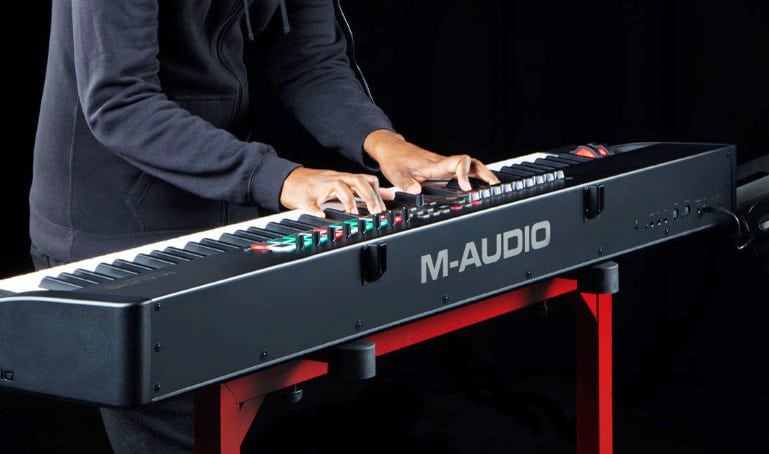
FEATURES: 16 RGB backlit pads
OTHER INFO: 9 assignable faders, 8 assignable knobs, and an arpeggiator.
- Realistic piano feel with weighted keys and aftertouch.
- Smart controls inspire creativity and eliminate wrong notes.
- Versatile controls for recording, automation, and live performance.
- Generous bundle of included software and virtual instruments
- Durable construction for professional use.
- Heavy and bulky (40.8 lbs).
- Lacks an LCD screen (uses OLED instead).
When you click ‘Check Price’, you’ll see there are loads of great places to buy this item. Our personal favorite is Sweetwater for the US, and Thomann and Gear4Music for the UK & Europe.
They are the largest music retailers, with excellent customer service, competitive prices, really fast shipping, and the longest guarantees.
The professional musician who wrote this article combined many things,
from the product build, manufacturer’s reputation through to feedback
from other users, to create our famous TedScore™.
Native Instruments Komplete Kontrol S88 MK2
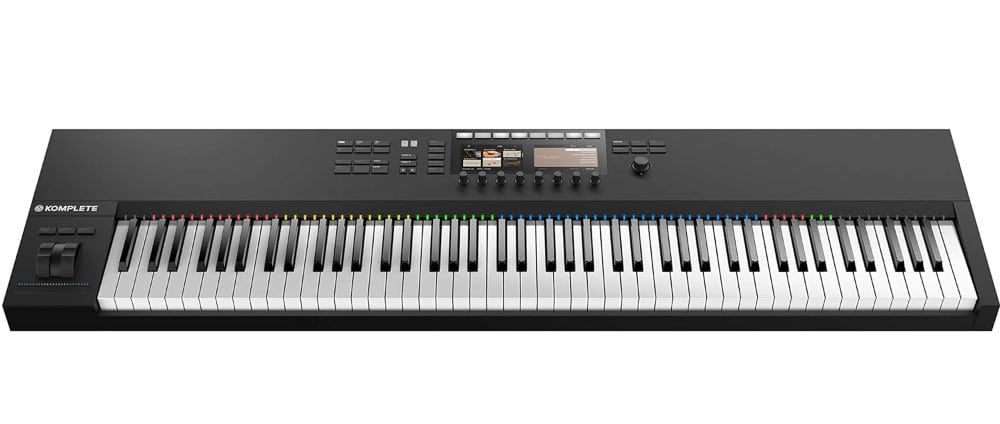
FEATURES: Comes with 14 Select and Maschine essentials
OTHER INFO: Innovative Native Map technology
- Comprehensive collection of top-tier virtual instruments and effects.
- Ergonomic controls including pitch and mod wheels, plus touch strip.
- Intuitive Light Guide system and Clear View display
- Easy chord mode for simplified harmonic performances.
- Seamless integration with MASCHINE and key DAWs (e.g., Logic Pro X, Ableton Live).
- Efficient tag-based preset browsing with instant sound previews.
- Demanding system requirements for optimal performance.
- Online activation required for software.
- No slider controllers
When you click ‘Check Price’, you’ll see there are loads of great places to buy this item. Our personal favorite is Sweetwater for the US, and Thomann and Gear4Music for the UK & Europe.
They are the largest music retailers, with excellent customer service, competitive prices, really fast shipping, and the longest guarantees.
The professional musician who wrote this article combined many things,
from the product build, manufacturer’s reputation through to feedback
from other users, to create our famous TedScore™.
Alesis V61 MKII MIDI Keyboard Controller
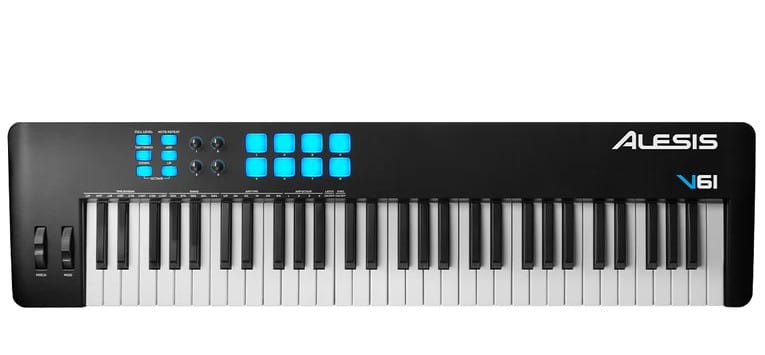
FEATURES:61 keys, 8 pads, and all the controls you need.
OTHER INFO: Weight: 3.3kg
- Ultra-portable design with lightweight construction
- Customizable MIDI messages for tailored control
- Plug-and-play with Mac, PC, and iOS, USB-powered for portability.
- MPC Beats software with sounds and tools, Melodics lessons for learning piano.
- Keys may not feel like a traditional piano.
- Fewer controls than some high-end models.
When you click ‘Check Price’, you’ll see there are loads of great places to buy this item. Our personal favorite is Sweetwater for the US, and Thomann and Gear4Music for the UK & Europe.
They are the largest music retailers, with excellent customer service, competitive prices, really fast shipping, and the longest guarantees.
The professional musician who wrote this article combined many things,
from the product build, manufacturer’s reputation through to feedback
from other users, to create our famous TedScore™.
Arturia Keylab Essential 3 61 Key, White
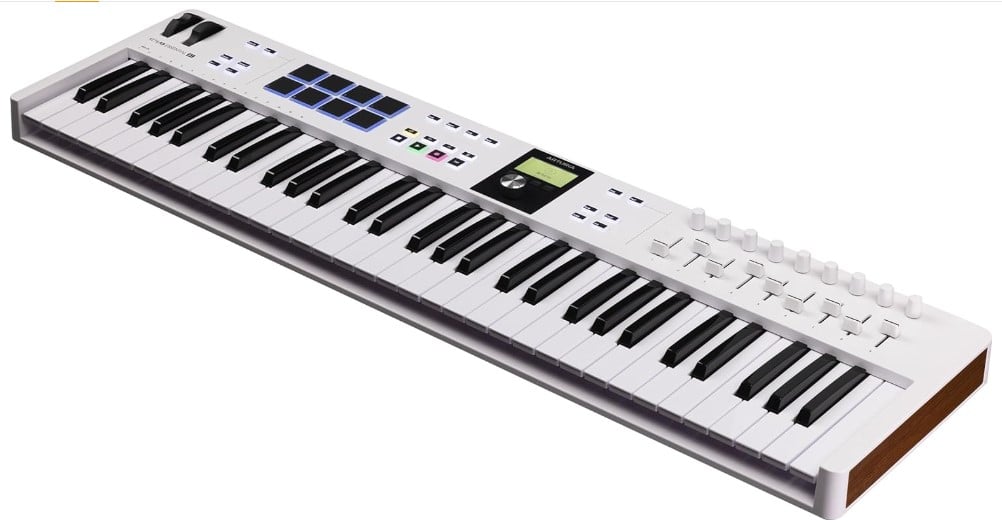
FEATURES: 8 touch & pressure-sensitive pads
OTHER INFO: Includes Ableton Live Lite, Analog Lab V, essential instrument sounds, and loop/sound libraries.
- User-friendly for both beginners and experienced producers
- Control options with encoders, faders, pads, and more
- Extensive DAW compatibility enhances workflow efficiency
- Includes a rich library of sounds and instruments for immediate creativity
- Supports expressive playing with velocity-sensitive keys and performance inputs
- Environmentally conscious design with USB-C connectivity for sustainability
- Players might find the lack of aftertouch and the synth action less satisfactory.
When you click ‘Check Price’, you’ll see there are loads of great places to buy this item. Our personal favorite is Sweetwater for the US, and Thomann and Gear4Music for the UK & Europe.
They are the largest music retailers, with excellent customer service, competitive prices, really fast shipping, and the longest guarantees.
The professional musician who wrote this article combined many things,
from the product build, manufacturer’s reputation through to feedback
from other users, to create our famous TedScore™.
Roland A-88MKII 88-Key MIDI Keyboard Controller
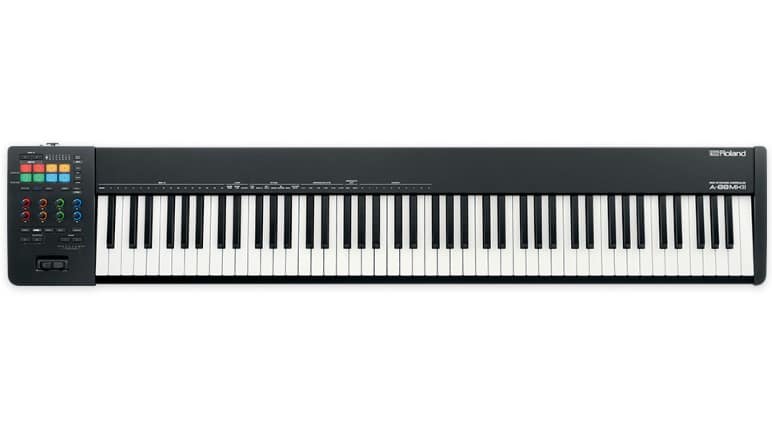
FEATURES: USB-C connectivity
OTHER INFO: PHA-4 Keyboard with escapement and ivory feel for a natural piano touch
- Superb build quality and playability
- Powerful creative features for sound layering and manipulation
- Modern connectivity and future-proof design
- Easy preset recall and customization options
- Compact design ideal for smaller studios
- Expensive compared to some other MIDI controllers
- Limited bundled software
When you click ‘Check Price’, you’ll see there are loads of great places to buy this item. Our personal favorite is Sweetwater for the US, and Thomann and Gear4Music for the UK & Europe.
They are the largest music retailers, with excellent customer service, competitive prices, really fast shipping, and the longest guarantees.
The professional musician who wrote this article combined many things,
from the product build, manufacturer’s reputation through to feedback
from other users, to create our famous TedScore™.
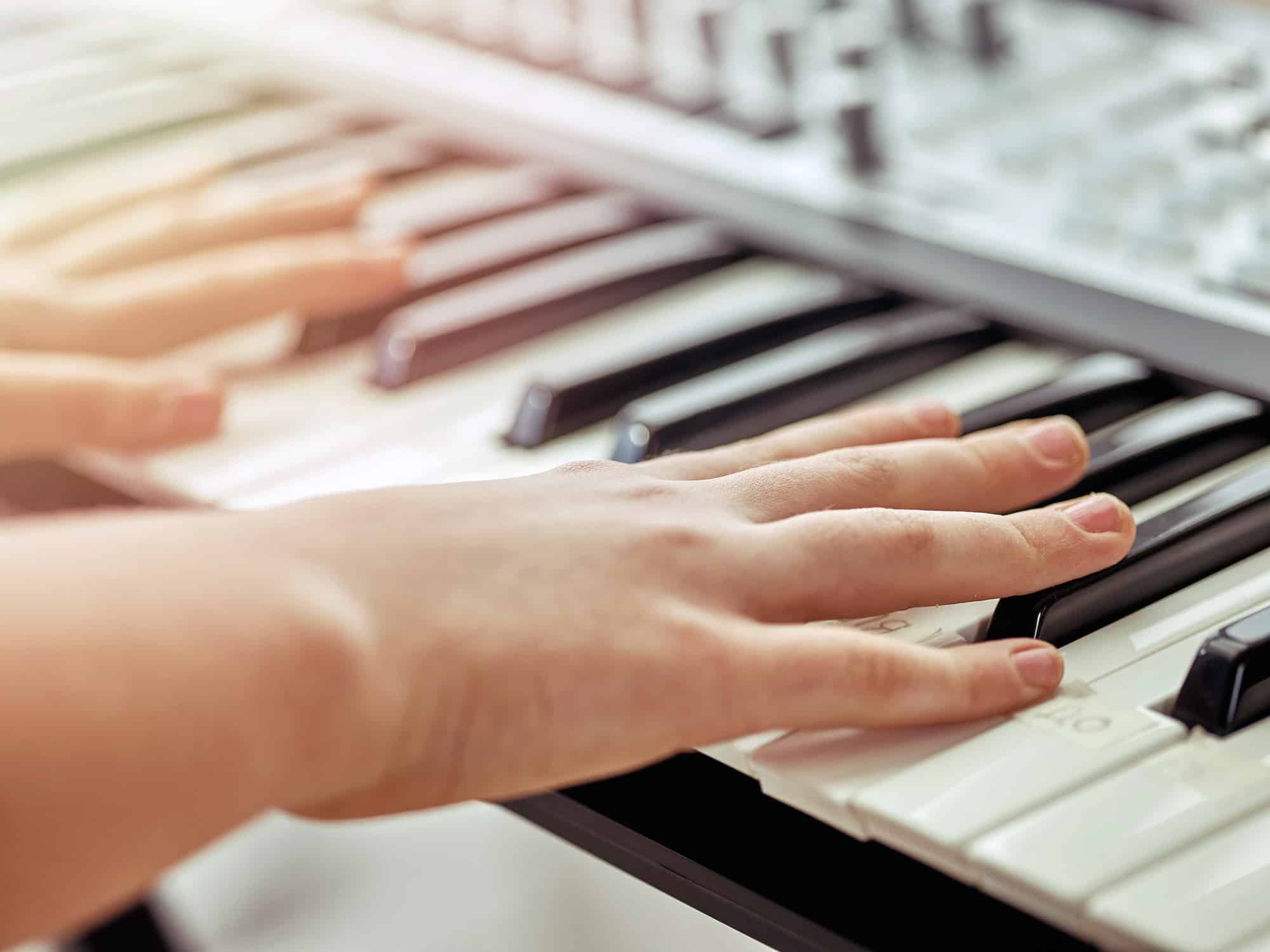
Tips for Getting the Most Out of Your
Weighted MIDI Keyboard
Virtual Instruments: Most MIDI keyboards come with bundled software or are compatible with virtual instrument plugins. These plugins offer a wide range of sounds, from pianos, organs, and strings to synths, drums, and percussion. Experiment with different sounds to find the ones that inspire you.
Sample Libraries: Sample libraries are collections of high-quality recordings of real instruments. They can provide a more realistic and nuanced sound compared to virtual instruments. Explore different sample libraries to find ones that match the type of music you want to create.
Posture and Hand Position: Maintaining proper posture and hand position is crucial for playing comfortably and avoiding injuries. Sit up straight with your feet flat on the floor and your forearms parallel to the ground. Curve your fingers slightly and strike the keys from the tips of your fingers.
Finger Exercises: There are many finger exercises available online or in piano books that can help you improve your dexterity, speed, and accuracy. Regularly practicing these exercises will improve your playing technique.
Knobs, Pads, and Sliders: Many weighted MIDI keyboards come with additional features like knobs, pads, and sliders. These controls can be assigned to various parameters in your virtual instruments or DAW, allowing you to control things like volume, filter cutoff, and attack. Experiment with these controls to create expressive and dynamic music.
Pedals: Best MIDI keyboard comes with sustain pedals, which can be used to sustain notes after you have released the keys. Some keyboards also include other pedals, such as sostenuto and expression pedals, which can provide further expressive control.
DAW Integration: Most MIDI keyboards are designed to integrate seamlessly with Digital Audio Workstations (DAWs). DAW transport controls allow you to record your performances, edit your MIDI data, and create complete songs.
Looping and Overdubbing: Use the looping and overdubbing features in your DAW to layer multiple parts on top of each other. This is a great way to create complex and textured arrangements.
Maintenance Tips for Keeping Your Weighted MIDI Keyboard in Top Condition
Maintaining a weighted MIDI keyboard is crucial for ensuring its longevity, performance, and the quality of music it produces. Below are some professional tips for keeping your keyboard in top condition.
Regularly dust your keyboard with a soft, dry cloth or brush to prevent signal and connection issues. Avoid using wet wipes or sprays.
For occasional stickiness or grime, use a slightly damp cloth or cotton swab with mild soap or alcohol. Never leave moisture behind, and consult the manual for weighted key removal.
Keep your keyboard away from liquids and avoid storing it in humid environments to prevent damage.
Be gentle when moving your keyboard to avoid physical damage to the keys, mechanics, and electronics.
For occasional stickiness or grime, use a slightly damp cloth or cotton swab with mild soap or alcohol. Never leave moisture behind, and consult the manual for weighted key removal.
Best Weighted Midi Keyboard
Summary
Choosing the best weighted MIDI keyboard depends on various factors such as budget, features, key action, and portability.
Models like the Native Instruments Komplete Kontrol S88 MK2 offer a high-quality Fatar keybed with fully-weighted hammer-action keys, providing a realistic piano feel. The Arturia Keylab Essential 3 61 Key is another top contender, known for its excellent build quality and comprehensive control features.
Each of these keyboards caters to different needs, from studio production to live performance, with their unique set of features and integrations.
I personally own the Roland A-88MKII, and use it every day with Logic, ProTools, and Sibelius. It feels great, reacts well, and looks fabulous in my studio.
When selecting the best weighted MIDI keyboard for your needs, consider the keybed quality, connectivity options, included software, and your personal preference in terms of tactile feel and responsiveness.
What’s your take on this?
Do you prioritize key action and feel, or are software integration and additional features more critical for your music production or performance setup?
We encourage you to share your experiences or preferences, as your insights could help others make a more informed decision.
And talking about scoring programs, have you read my latest review The Best Music Notation Software…
FAQ's
Yes, MIDI keyboards with weighted keys are available. These keyboards mimic the feel of playing on a grand piano, providing a more authentic playing experience. They are popular among keyboard players who desire the tactile feedback of weighted keys for dynamic performance and composition, integrating easily with sound banks for versatile music production.
The “best” digital piano with weighted keys depends entirely on your individual needs and budget. Some popular options include the Yamaha Arius YDP-S55, Kawai ES120, and Nord Stage 4. These pianos offer a variety of features, sounds, and price points to choose from.
Weighted keys can be beneficial for keyboard player, especially those who play piano or want a more realistic playing experience. Weighted keys provide a more natural resistance when pressed, similar to the feel of an acoustic piano. This can help improve finger strength, technique, and overall playing accuracy.
Fully weighted keyboards mimic the feel of acoustic pianos by having keys with consistent weight throughout, offering a realistic playing experience. They are ideal for classical pianists or those transitioning between digital and acoustic pianos.
Semi-weighted keyboards offer a lighter playing experience than fully weighted keyboards, with some variation in weight across the keys (heavier in the bass, lighter in the treble). They are suitable for various genres, especially those requiring faster playing or a lighter touch.











so i’m in the market for a midi keyboard and been reading a lot on what to get. this article’s got some good points on weighted keys but i dont know if i really need all that for just making beats and stuff. and whats aftertouch anyway? sounds complicated. maybe i’ll just stick to something simple.
While the article provides a valuable overview on weighted MIDI keyboards, I believe there’s an oversimplification in categorizing key actions into just fully and semi-weighted. The nuances between hammer action and graded hammer action, for instance, play a huge role in simulating an authentic acoustic piano experience. It might have added value to delve deeper into these aspects for readers aiming for the highest possible fidelity in their playing experience.
Hey, just wanted to drop a quick note saying how much I enjoyed this piece. Was always a bit lost with all the different key actions and what they meant but this article spelled it out super clear. Fully weighted keys seem like the way to go for that real piano feel, huh? Also, those maintenance tips are golden, gonna start using them to take care of my gear. Thanks for sharing all this!
Really loved the breakdown of features to look for in weighted MIDI keyboards, Robert Emery. As someone still exploring, I’m curious about how significant the aftertouch capability is? Does it make a big difference for genres outside of classical music?
Aftertouch?! As it’s midi keyboards, I wouldn’t worry about that too much.
Aftertouch adds a lot of expressive capacity, especially for electronic and ambient music. Definitely not just for classical!